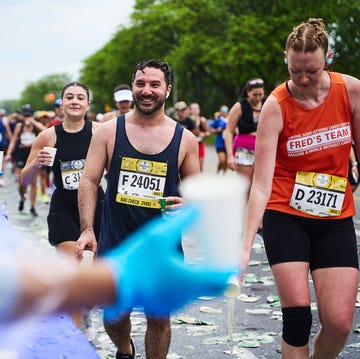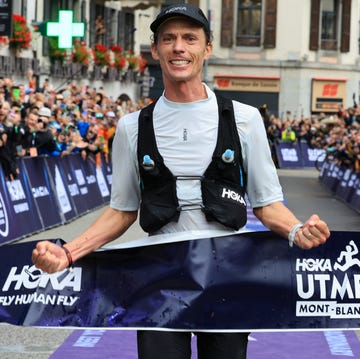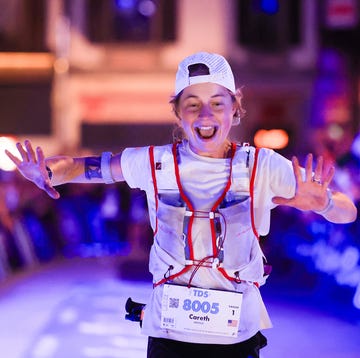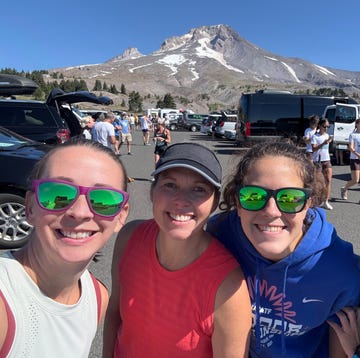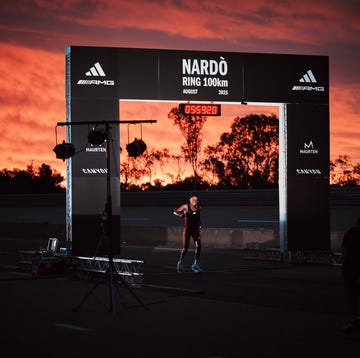On Saturday, June 28, 369 intrepid trail runners will toe the starting line of the 100-mile Western States Endurance Run at the base of Palisades Tahoe ski resort in Olympic Valley, California, on a quest to reach the finish line in the small town of Auburn 100 miles to the west. It’s the most celebrated 100-mile race in the U.S. and, as with years past, it has a stacked field of the top dozen or so U.S. and international ultrarunners ready to give it a go.
How to Watch the Western States 100
This year’s 52nd annual will once again be shown via livestream on the race’s YouTube channel beginning Saturday morning at 5 a.m. PST (8 a.m. EST) and continuing until the race’s 30-hour cutoff at 11 a.m. PST (2 p.m. EST) on Sunday. More than 500,000 fans in 117 countries tuned into last year’s livestream. You can also follow the official race leaderboard and keep tabs on the race’s Instagram feed.
Neither course record holders—American megastars Jim Walmsley of Flagstaff, Arizona, and Courtney Dauwalter, of Leadville, Colorado—are running this year’s race. Walmsley, 35, a four-time Western States champion, was supposed to run it this year, but is recovering from an injury and plans to run the August 29 Ultra-Trail du Mont-Blanc (UTMB) in Chamonix, France, where he became the first U.S. male runner to win in 2023. Dauwalter, 40, a two-time Western States champion, also plans to race UTMB in Chamonix.
If you want to tune into the livestream for the finish, clear your schedule for Saturday night. Walmsley’s men’s course record of 14:09:28 (2019) equates to a 7:09 p.m. PST (10:09 p.m. EST) finish, while Dauwalter’s women’s course record of 15:29:33 (2023) would mean someone finishing by 8:29 p.m. PST (11:29 p.m. EST).
History of the Race
Although organized trail racing in the U.S. has its roots dating back to the early 20th century, the Western States 100 got started after Gordy Ainsleigh famously ran the entire course of the 100-mile Western States Trail Ride equestrian event without a horse in 1974. Ainsleigh, a bold and brash 27-year-old, had ridden in the event on a horse in 1971 and 1972, but wasn’t able to enter in 1973 because his horse was lame. He was invited back in 1974, but he could secure a horse so he decided to run the 100 miles all the way to the finish line in Auburn in under 24 hours.
“I figured I’d have another horse by then, but I never got around to it,” Ainsleigh said. “I didn’t get around to it, so as the spring rolled on, I decided to just run it. I ran because it was the most important event of the year, and the most important thing in my life at the time, and I just wanted to be a part of it. I didn’t know if I couldn’t finish it, but I knew I could take one more step. So I kept taking one more step and that’s what got me there.”
Ainsleigh struggled but he persevered and reached the finish line in 23 hours and 42 minutes, and out of his dramatic effort and persevering spirit (and after Ken Shirk repeated the feat in 1976 in 24:30), the Western States Endurance Run was born in 1977 when 16 runners toed the starting line at the first official race. Since then, it’s become a legendary event, one that was a catalyst for the genre of 100-mile trail racing in the U.S. and remains the most revered trail race in North America.
It’s also become one of the hardest races in the world to get into. Because it traverses through wilderness areas and other protected lands, it is limited by several land agency permits to a field of only 369 runners. Runners are chosen through a complicated entry system that includes a weighted lottery, Golden Tickets awarded to top finishers of qualifying races around the world, re-entry for the previous year’s top 10 finishers, and VIP entries and special considerations. There were 9,993 runners entered in last December’s lottery for this year’s race.
The race sends runners over the 8,750-foot summit of the Emigrant Pass above the ski area, then on a long and winding route along the Western States Trail through the hot sun-exposed American River Canyon—where temperatures typically reach the upper 80s to mid-90s—and eventually to the Placer High School track in Auburn. In all, the course includes 18,000 feet of elevation gain and 23,00 feet of elevation loss.
The Western States 100 has remained the most prominent trail race in North America amid a period of big growth, in part by helping the sport navigate the challenges of commercialism, professionalism, and social change. It has embraced inclusiveness worked to attract more women and greater diversity to the sport.
“The Western States has a magnetic draw for the community that has been inspiring and guiding the community through this sea of growth and change,” said Topher Gaylord, the president Western States Endurance Run Board of Directors, a seven-time finisher of the race who has also crewed and paced numerous runners in the race through the years. “What is it about Western States that has continued to lead the sport of trail running through the years? Is it the fact that it's the first 100-mile running race in the world? Is it the fact that it's one of the most competitive 100-milers in the world? Is it the history of the trail that dates back to Native American peoples? Is it that prize belt buckle you earn as a finisher? Is it the prestige and the traditions? When you ask most people, they just answer, ‘It’s Western States.’ It’s all of that.”
Women’s Race Favorites
Five of the top 10 women return from last year’s race, including Fuzhao Xiang, 33, of China, who finished second (16 hours, 20 minutes, 3 seconds), 33 minutes behind American Katie Schide. (Schide, who lives in France, is running the Hardrock 100 in Silverton, Colorado, on July 11.)
Other top returning runners are Eszter Csillag, 40, a Hungarian runner based in Hong Kong who finished third in Western States each of the past two years; Emily Hawgood, 30, of Zimbabwe, who has four straight top-10 finishes, including fourth last year; Sweden’s Ida Nilsson, 43, a two-time NCAA champion on the track for Northern Arizona University (3,000-meter steeplechase in 2004, indoor 5,000-meter run in 2005) who placed sixth last year, and last year’s seventh-place finisher Heather Jackson, 41, of Bend, Oregon, who was formerly a top Ironman triathlete and now splits time between ultrarunning and gravel bike racing. (Jackson won the 350-mile Unbound Gravel XL race in Kansas on May 31, finishing in a record 20:57:57.)
Tara Dower, 31, of Durango, Colorado, who set the overall fastest known time (FKT) on the Appalachian Trail, is a key competitor in the women’s race, as is Riley Brady, 30, a nonbinary athlete from Boulder, Colorado, who has finished 14th in 2023 and is coming off a big win at the Black Canyon Ultras 100K race on February 8 in Arizona.
Men’s Race Favorites
On the men’s side, the primary favorites are Kilian Jornet, 37, a legendary Spanish runner living in Norway, who is a a four-time UTMB champion and won Western States 100 in 2011; Adam Peterman, 29, of Missoula, Montana, a former University of Colorado cross country runner who won both Western States and the 78K race at the World Mountain & Trail Running Championships in Thailand in 2022, and running coach and social media personality David Roche, 37, of Boulder, Colorado, who won Colorado’s Leadville 100 last summer in record-breaking time.
Jornet hasn’t raced much in the past two years, instead focusing on his young family (his wife, Emelie Forsberg gave birth to their third child in March and other big projects that have blended trail running and mountaineering, including his 16-stage, 82-summit journey through the mountains of Europe last summer.
In March, he finished second behind Walmsley in the Chianti Ultra Trail 120k in Italy, setting up what many hoped to be a showdown at Western States before Walmsley’s knee injury forced him to withdraw. Jornet ran the 2.15-mile Ascent race at the Broken Arrow Sky Race last Friday, but, after starting strong, he faded to a jet lag-induced 23rd-place finish.
But he says he’s fit and ready to race Western States for the third time. In 2010, he finished third behind Americans Geoff Roes and Antron Krupicka in an epic battle that was eventually made into an award-winning feature film called “Unbreakable.” He returned the next year to win in a then-course record 15:34:24.
“A lot has changed in ultrarunning (since 2011),” Jornet said Friday. “When I first did it (in 2010 and 2011), I didn’t really have a time plan. It was more about going out and seeing how others did out on the course and not really thinking too much except drinking water and eating some food at aid stations. But the sport has changed a lot and it’s much more competitive now. There’s much more that goes into races like this now, from training to heat, to nutrition, to gear. It’s become very neuromuscular, very stressing and demanding in different ways. Because it's not that you need to run fast, it’s that you need to run not slow for a very long time.”
Other top contenders in the men’s race include Daniel Jones, 34, of New Zealand, a 2:16 marathoner who was fourth and fifth, respectively, the past two years, Vincent Bouillard, 31, of Annecy, France, who was the surprise winner of last summer’s Ultra-Trail du Mont-Blanc in Chamonix, France, and Rod Farvard, 29, of Mammoth Lakes, California, who gave Walmsley a run for his money last year, eventually finishing 11 minutes behind him in second place 14:24.
Other Runners to Watch
For the first time, this year’s race includes five runners who are 70 and older. Among them are 80-year-old Nick Bassett, of Cheyenne, Wyoming, who has completed five races of 50K (approximately 31 miles) or longer in 2025, 70-year-old Michel Poletti, the co-founder of the UTMB race in Chamonix, and 70-year-old Jim Howard, who won Western States in 1981 and 1983 in two of the fastest early races in the event.
Howard stopped running in his mid-50s because of knee problems, eventually undergoing two knee replacements in 2018 at the age of 63. After a year of getting used to his new, mechanical knees, he started training again, ultimately returning to run six 100K races over the past several years, including his second-place overall finish in the Jackpot Ultra 100K near Las Vegas in February.
Another runner to watch is Adam Popp, 46, of Lafayette, Colorado, is the first above-the-knee to enter the race. A 12-year combat veteran of the U.S. Air Force, Popp served deployments to Iraq and Afghanistan as an explosive ordinance disposal team leader, he lost most of his right leg while working to disarm a roadside bomb in Afghanistan.
Popp has completed numerous endurance races since 2016, including five 100-mile races, seven JFK 50-miler finishers, and an Ironman triathlon. In 2024, he won the Boston Marathon’s Para Elite division (T61/63) and set a T63 world best of 3:08:52 at the London Marathon six days later.
Last year, 286 of the 369 runners finished the race (about 78 percent), including 60 in the final hour before the cut-off, a moment that’s become known as the Golden Hour.
“This has always been a race where people find out what’s in their heart, their mind, their soul and what they’re physically and mentally made of,” Gaylord said. “We celebrate every runner from start to finish. If you haven’t experienced Golden Hour on Sunday morning, it’s a very powerful moment to witness.”
Check out the complete list of this year’s Western States entrants and more details about the race.
Brian Metzler is a Boulder, Colorado, writer and editor whose work has appeared in Runner’s World, Sports Illustrated, ESPN, Outside, Trail Runner, The Chicago Tribune, and Red Bulletin. He’s a former walk-on college middle-distance runner who has transitioned to trail running and pack burro racing in Colorado.











